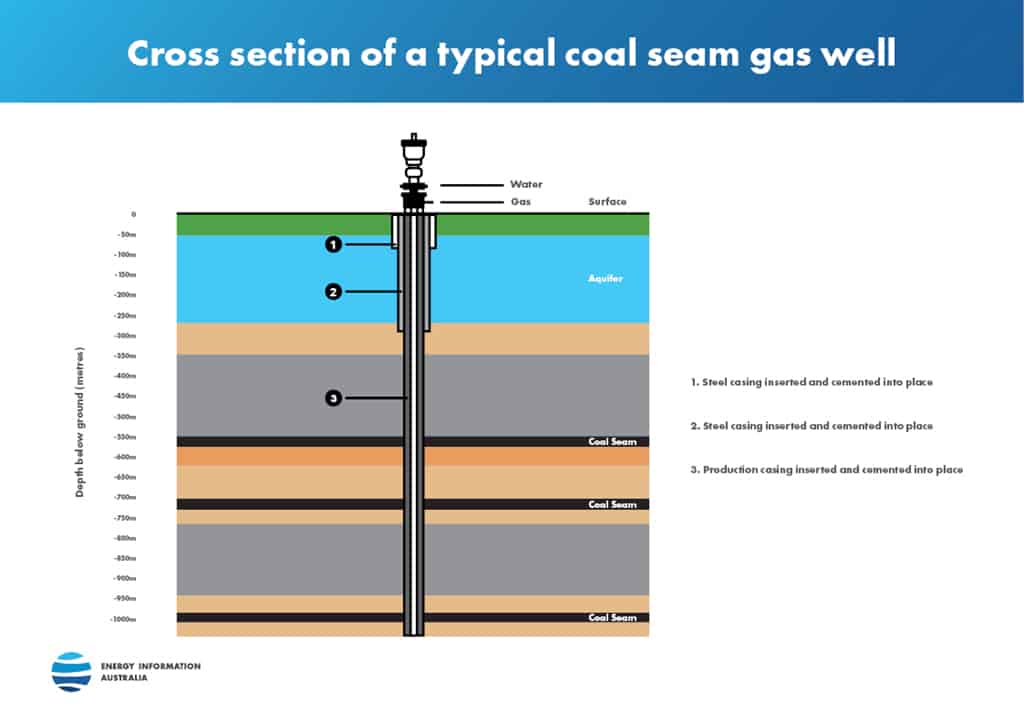High Point Vents in Coal Seam Gas Production
What is a high point vent?
In onshore coal seam gas (CSG) production, high point vents (HPVs) are valves installed along the highest points of a water gathering pipeline to allow the release, or venting, of small amounts of gas in the water.
Why are HPVs needed?
For background – CSG comes from coal which is a sedimentary rock formed by the compressed remains of organic material such as plants. CSG is natural gas that has collected in underground coal seams by bonding to the surface of coal particles. The coal seams are generally filled with water and it is the pressure of the water that keeps the gas as a thin film on the surface of the coal. To release the gas from the coal, the water within the coal seams is pumped out to allow the gas to flow to surface.
In CSG production, the water and gas produced from coal seams are separated at the well head and pumped along dedicated gathering lines (dual pipelines). The gas is piped to a gas processing facility for compression, and the water is piped to water storage and treatment plants.
Sometimes, very small amounts of gas enter the water gathering line.
Operationally, it is important to eliminate gas from the water gathering line to maintain the functionality of the pipeline. Operators are also focused on mitigating the entry of gas into water pipelines to minimise the loss of commodity and reduce fugitive emissions.

How much gas is released from CSG operations, including HPVs?
The CSIRO continues to conduct research into fugitive emissions in the unconventional gas industry and this information is used by operators to reduce their emissions.
Fugitive emissions are losses, leaks and other releases of methane to the atmosphere that are associated with industries producing natural gas, oil and coal. They also include CO2 emissions associated with flaring of excess gas to the atmosphere.
One CSIRO study into CSG operations in QLD and NSW showed very low emissions and that many of the leaks detected were preventable and easily fixed.
In Australia, fugitive emissions from all gas production (including CSG) are estimated to account for about 2.5% of total greenhouse gas emissions, according to the CSIRO. This figure also includes CO2 emissions associated with flaring of excess gas to the atmosphere.
Flaring or burning of natural gas significantly reduces greenhouse gas emissions that would be created by simply venting unburnt gas and is used as an essential safety procedure in gas production.
Operators are required to report emissions via the National Greenhouse and Energy Reporting (NGER) scheme.
Can HPVs release CSG water?
HPVs are not designed to release CSG water. There have been a few cases of coal fines (small particles) affecting HPV operations, resulting in CSG water releases. Any leak must be reported to the government under the operators’ environmental authority, which include conditions to identify, clean up and mitigate any leaks.
It’s worth noting, CSG water (or produced water) is often saline having been underground for a long time. It has a number of potential uses including applications in the agriculture and industrial sector.
Strict control and regular physical and remote monitoring
Australia’s CSG industry is in eastern Australia and is strictly regulated through state and federal authorities.
There are many requirements operators must meet to be granted an Environmental Authority for gas production, plus further requirements for fugitive emission management and monitoring programs.
At an operational level, industry operators monitor HPVs directly through routine inspections or indirectly through separator and gathering system pressure monitoring.
There are a range of indicators used by operators to identify and mitigate (where practicable) releases through HPVs as these are essentially a loss of a commodity.
What about air quality monitoring around CSG?
GISERA’s air quality monitoring program (Ambient air quality in the Surat Basin, Queensland) included a cumulative assessment of impacts across Queensland’s Surat Basin. This was the first comprehensive ambient air quality study in a CSG region of Australia. The Queensland State Government continues to live stream air quality data reporting from three stations in the Surat Basin region (Miles, Hopeland and Upper Humbug in the Tara region).
The final report details extensive monitoring, the contributors to air – and also ground – quality, including mining, forestry, oil and gas, and agriculture and includes cumulative impact assessment, and information on raw CSG gas quality.
The report stated:
“Emissions from the CSG industry were likely to have contributed to the majority of the largest methane concentration events, however none of these methane events coincided with an air quality exceedance for other pollutants measured. Where detected, VOC and aldehyde concentrations in the gas fields were generally very low and well below relevant air quality objectives, typical of other rural locations.”
“To conclude, this study found that air quality in the region is well within relevant air quality objectives for the majority of the time for a wide range of gaseous pollutants that are potentially emitted by CSG activities.”